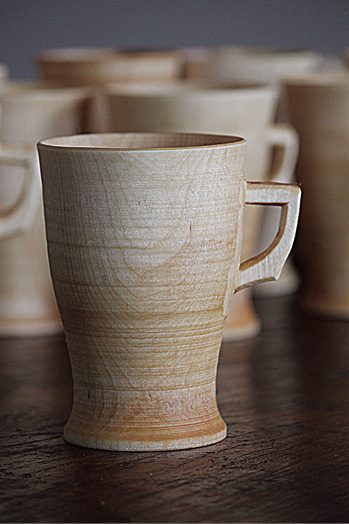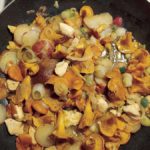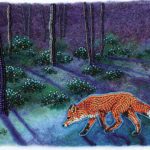As I sit down to dinner with my wife Jazmin each evening, I am surrounded by treasures. On my dining table, made of hundred-year-old Chestnut boards, beeswax candles in turned wooden candlesticks cast a warm light. We serve ourselves with hand carved wooden ladles from bowls made by fellow woodturners and local potters, filled with tasty local produce and meat onto wooden plates and bowls. We drink from wooden cups and glassware, use linen napkins, thrifted or woven by Jazmin, and eat with wooden forks and spoons, carved fine and thin for effortless use. This scene full of handmade work feels as luxurious as it stands out for how uncommon it is. Ironically, wooden tableware, used day in and day out by our ancestors, was common not so long ago.
In the forested lands around the world, trees have provided an important resource for millennia. Even in barren lands like the Arctic, wood that was washed up on shore was a key resource. We often forget that the trees around us provide abundance in our lives. The electricity that runs our homes is supported by wooden poles. The concrete foundations of our buildings were formed with wood. Our homes themselves are framed with and covered with wood.
Just a few hundred years ago, even our tableware was made from trees—large wooden bowls for mixing and serving, small bowls and plates to hold our food, wooden spoons for cooking, stirring and eating, cups for our drinks. As a woodturner, carver and maker/designer of wooden housewares, I have focused intensely on the history and use of woodenware.

My research took me to Borås, Sweden, the land of my ancestors and namesake. For hundreds of years beginning in the late 1600s, Borås and the surrounding area was an important woodturning region. Because of poor soils and large Beech tree forests, the inhabitants couldn’t farm, so they began turning wood into items they could peddle to feed their families. Each year, a hundred or so families produced tens of thousands of bowls, plates, and lidded boxes for export. I visited museum collections of these wooden items to learn how they were made. I wanted to see and feel a well-used bowl and plate made by someone who made thousands of them. How thin were they? Were there tool marks or were they smooth? What I learned informed the design of the plates and bowls I make today.
In search of wooden cups, I visited the Jorvik Center where the Coppergate archeological site is. Vikings settled in York, England for almost 100 years between 866-954 A.D. and one of the largest finds of wooden objects was discovered at this site, including wooden cups and bowls. Those cups were turned on human-powered lathes just like in Sweden hundreds of years later. I saw what a wooden cup was like from an era when their use was common place. They were finely made and thin walled. It was amazing to see the tool marks left by skilled turners from a thousand years ago.
I studied woodenware in Japan as well, a place where wooden tableware has been used since the Stone Age, but I’ll save that for another time. In earlier times it was common to own not much more than the clothes on one’s back, a wooden bowl and spoon, and a knife. Metal utensils, glassware and fine ceramics were expensive and reserved for the wealthy. However, during the years of the Industrial Revolution when more modern methods of production and transport were developed, along with the rise of democracies and with it capitalism and new technologies, things that were reserved for the wealthy were now affordable and readily available to commoners. So wooden tableware in the west was eventually abandoned. This new era changed the lives of common folks in many ways.
A few hundred years later, modern people surrounded by technology and ready-made items are trying to reconnect to the natural world. I feel that wooden tableware connects me to the forest and to the physical world around me. It’s a local renewable resource and connects me to the past in a direct way. Woodenware is warm and quiet—no clanking—and it’s strong—a wooden plate can drop without shattering. This probably sounds like a sales pitch because it is. Try using woodenware—you may like it. Surrounding yourself with beautiful handmade things brings beauty into your life. And wood is beautiful.
Jarrod Dahl is a lead instructor at North House Folk School, where traditional craft is taught on the shore of Lake Superior.






